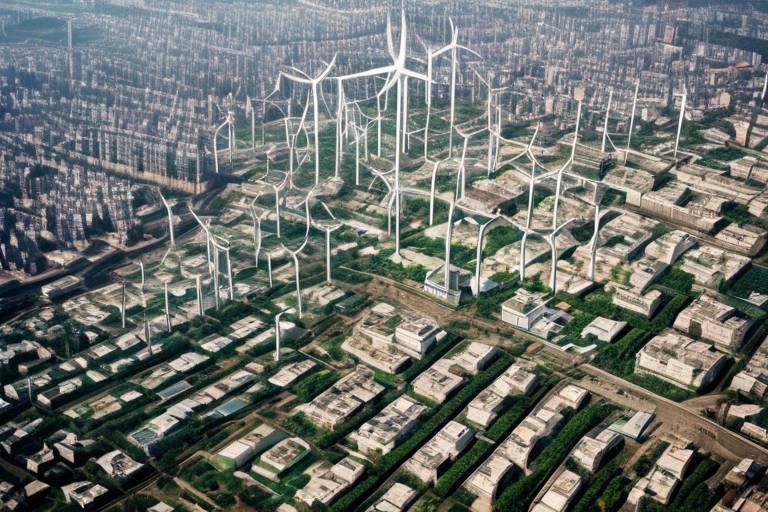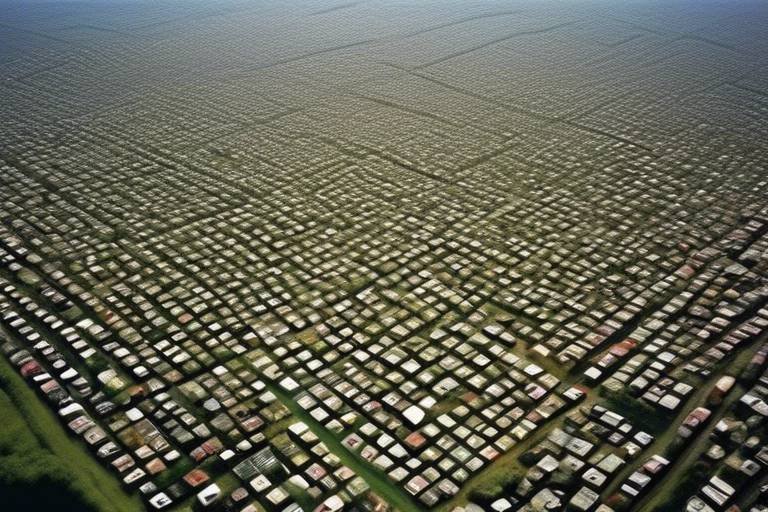Can Urban Areas Benefit from Renewable Energy Sources?
As we plunge deeper into the 21st century, the conversation around sustainable living has never been more critical. Urban areas, often seen as the bustling heart of modern civilization, are also significant contributors to environmental degradation. But what if there was a way to turn this around? What if cities could harness the power of renewable energy sources to not only mitigate their environmental impact but also enhance their economic and social fabric? This article explores the potential advantages of integrating renewable energy in urban settings, highlighting the multifaceted benefits—environmental, economic, and social—while discussing various technologies and strategies for implementation.
One of the most compelling reasons to adopt renewable energy in urban areas is its profound environmental impact. Renewable energy sources, such as solar, wind, and hydroelectric power, significantly reduce greenhouse gas emissions. Imagine a city where the air is cleaner, the skies are clearer, and the overall quality of life is enhanced. By transitioning to renewables, urban centers can combat climate change head-on, leading to a healthier environment for all residents. Not only does this shift improve air quality, but it also reduces the urban heat island effect, making cities more livable. In fact, studies show that cities adopting renewable technologies have seen a marked decrease in respiratory illnesses and other pollution-related health issues. Isn't it time we prioritize our planet and our health?
But the benefits of renewable energy aren't just limited to the environment; they extend into the economic realm as well. Adopting renewable energy can stimulate local economies by creating jobs and reducing energy costs. Think about it: more jobs mean more income for families, which translates to increased spending in local businesses. This creates a ripple effect that can uplift entire communities. For urban areas, investing in renewable technologies isn't just an environmental decision; it's a smart financial strategy. With the right investments, cities can lower their energy bills, allowing funds to be redirected to other critical services such as education and public safety.
The renewable energy sector is rapidly growing, providing numerous job opportunities in urban areas. From solar panel installers to wind turbine technicians, the types of jobs created are diverse and plentiful. The best part? Many of these roles require skills that can be learned through short training programs rather than lengthy college degrees. This is a game-changer for many individuals looking to enter the workforce or switch careers. The renewable energy industry is expected to create millions of jobs globally, and urban areas can be at the forefront of this revolution.
To equip individuals for jobs in renewable energy, training programs are essential. Various educational initiatives are already in place, aimed at preparing the workforce for this transition. Community colleges and vocational schools are stepping up, offering courses that cover everything from basic electrical skills to advanced renewable energy technologies. These programs not only provide valuable skills but also foster a sense of community and resilience. By investing in education, urban areas can ensure that their residents are well-prepared for the jobs of the future.
Moreover, local businesses can thrive by embracing renewable energy solutions. Small enterprises that adopt sustainable practices often see a boost in their reputation, attracting eco-conscious consumers. Additionally, by reducing energy costs through renewable sources, these businesses can reinvest those savings into growth and innovation. It's a win-win situation! When local businesses succeed, the entire community benefits economically.
Another significant advantage of renewable energy is the potential for energy independence. Urban areas often rely heavily on external energy sources, making them vulnerable to price fluctuations and supply disruptions. By investing in renewable energy, cities can produce their own power, reducing reliance on fossil fuels and enhancing resilience against market volatility. Imagine a city that generates its own energy—how empowering would that be? This independence not only stabilizes energy prices but also promotes local energy security.
Advancements in technology play a crucial role in the adoption of renewable energy in urban settings. The latest innovations make renewable energy more accessible and efficient than ever before. For instance, smart grid technology enhances energy distribution and management in urban areas. These smart grids optimize renewable energy usage by intelligently balancing supply and demand, ensuring that energy is available when and where it’s needed most.
Smart grid technology is revolutionizing how we think about energy distribution. By integrating digital technology into the electricity network, cities can manage energy resources more effectively. This means fewer outages, better integration of renewable sources, and a more reliable energy supply overall. It's like giving the city's energy system a brain, allowing it to learn and adapt over time.
Energy storage technologies are vital for managing renewable energy supply and demand. As we know, solar and wind energy are not always available. This is where storage solutions come into play. By utilizing batteries and other storage technologies, urban areas can store excess energy generated during peak production times and use it when demand is high. This capability not only enhances energy reliability but also maximizes the benefits of renewable energy integration.
- What are the main benefits of renewable energy in urban areas?
Renewable energy benefits urban areas by reducing greenhouse gas emissions, creating jobs, lowering energy costs, and enhancing energy independence.
- How can cities implement renewable energy solutions?
Cities can implement renewable energy solutions through investments in solar panels, wind turbines, and energy storage technologies, as well as by establishing training programs for the workforce.
- What types of jobs are available in the renewable energy sector?
The renewable energy sector offers various job opportunities, including solar panel installers, wind turbine technicians, and energy efficiency consultants.

Environmental Impact
When we talk about the of renewable energy sources, it’s like opening a treasure chest filled with possibilities for urban areas. Imagine a city where the air is cleaner, the skies are bluer, and the overall health of its inhabitants is significantly improved. This isn’t just a dream; it’s a reality that can be achieved through a transition to renewable energy. By harnessing the power of sources like solar, wind, and hydro, urban areas can dramatically reduce their greenhouse gas emissions, which are a major contributor to climate change. Studies show that cities that adopt renewable energy can see a reduction in air pollutants, leading to a healthier population and a decrease in respiratory diseases.
Furthermore, the shift to renewable energy not only helps in combating climate change but also fosters a more sustainable urban environment. For instance, cities can implement green roofs and solar panels on buildings, turning concrete jungles into eco-friendly havens. This not only helps in energy conservation but also enhances urban biodiversity. With more plants and greenery, cities can improve their urban heat island effect, leading to cooler temperatures during hot summer months. The integration of renewable energy technologies can also lead to the creation of green spaces, which are essential for mental well-being and community engagement.
But how do these changes actually impact the environment? Let’s break it down:
- Reduction in Air Pollution: By utilizing renewable energy, urban areas can significantly lower the emissions from fossil fuels, leading to better air quality.
- Conservation of Resources: Renewable energy sources are abundant and sustainable, reducing the depletion of finite natural resources.
- Climate Resilience: Cities that adopt renewable energy technologies are better equipped to handle the impacts of climate change, such as extreme weather events.
Moreover, the environmental benefits extend beyond just cleaner air. The integration of renewable energy can lead to improved water quality, as less runoff from fossil fuel extraction and transportation occurs. Urban areas that invest in renewable technologies often experience a decrease in water pollution, which is vital for maintaining healthy ecosystems. In essence, transitioning to renewable energy isn’t just about energy; it’s about creating a sustainable future for generations to come.
In conclusion, the environmental impact of integrating renewable energy sources in urban settings is profound. It’s an opportunity to not only combat climate change but also to enhance the quality of life for city dwellers. As we continue to innovate and adopt these technologies, the potential for a cleaner, greener urban landscape becomes increasingly attainable.

Economic Advantages
Adopting renewable energy sources in urban areas not only contributes to environmental sustainability but also brings a plethora of that can invigorate local communities. Imagine a bustling city where solar panels dot the rooftops, and wind turbines spin gracefully in the distance. This vision is becoming a reality, as cities worldwide recognize the potential of renewable energy to transform their economies. By investing in renewable technologies, urban areas can stimulate growth, create jobs, and significantly reduce energy costs.
One of the most compelling benefits of integrating renewable energy is the potential for job creation. The renewable energy sector is rapidly expanding, offering a diverse array of employment opportunities. From engineers and technicians to sales professionals and project managers, the job market is evolving to meet the needs of this green revolution. According to recent studies, the clean energy sector is expected to create millions of jobs globally, and urban areas are well-positioned to capitalize on this trend. The types of jobs created span various fields, including:
- Installation and maintenance of solar panels and wind turbines
- Research and development in energy efficiency technologies
- Project management for renewable energy projects
- Energy auditing and consulting services
To ensure that the workforce is equipped with the necessary skills, training programs are essential. Educational initiatives that focus on renewable energy technologies are emerging in urban settings, providing individuals with the knowledge and skills needed for this growing industry. Partnerships between local governments, educational institutions, and private companies are vital for developing effective training programs. For instance, community colleges can offer certificate programs in solar energy installation, while vocational schools can teach skills related to energy efficiency and management.
Moreover, the shift towards renewable energy can significantly benefit local businesses. By embracing sustainable practices, small enterprises can reduce their operational costs, making them more competitive in the marketplace. For example, businesses that invest in energy-efficient technologies can lower their utility bills, allowing them to allocate resources to other critical areas such as marketing or product development. Additionally, as consumers become more environmentally conscious, businesses that adopt green practices can attract a larger customer base, enhancing their brand reputation and loyalty.
Another crucial aspect of the economic advantages of renewable energy is the potential for energy independence. Urban areas often rely heavily on external energy sources, making them vulnerable to price fluctuations and supply disruptions. By investing in local renewable energy projects, cities can reduce their dependence on fossil fuels and enhance their resilience against market volatility. This transition not only stabilizes energy costs but also keeps money circulating within the local economy, fostering growth and development.
In conclusion, the economic advantages of integrating renewable energy sources in urban areas are substantial. From job creation and training opportunities to benefits for local businesses and increased energy independence, the potential for growth is immense. As cities continue to embrace renewable technologies, they pave the way for a more sustainable and prosperous future.
1. What types of jobs are available in the renewable energy sector?
The renewable energy sector offers a wide range of jobs, including installation and maintenance of solar panels, wind turbine technicians, energy efficiency consultants, and project managers.
2. How can local businesses benefit from renewable energy?
Local businesses can reduce their operational costs through energy efficiency, attract environmentally conscious customers, and enhance their brand reputation by adopting sustainable practices.
3. What role do training programs play in the renewable energy sector?
Training programs are essential for equipping individuals with the skills needed to work in the renewable energy sector, ensuring a skilled workforce to meet the industry's demands.
4. How does renewable energy contribute to energy independence?
By investing in local renewable energy projects, urban areas can reduce their reliance on external energy sources, leading to greater stability in energy costs and local economic growth.

Job Creation
The renewable energy sector is not just a buzzword; it's a booming industry that is rapidly transforming urban landscapes and creating a wealth of job opportunities. Imagine walking down a city street and seeing not just skyscrapers but also solar panels and wind turbines. This shift towards sustainable energy is not only vital for our planet but also a goldmine for job seekers. The types of jobs being generated are diverse, ranging from technical positions like solar panel installers and wind turbine technicians to roles in project management and sales. Each of these positions requires different skills, creating a rich tapestry of opportunities for individuals with varying backgrounds.
To give you a clearer picture, let’s break down some of the key roles in the renewable energy sector:
- Solar Panel Installers: These skilled workers are responsible for setting up solar panels on rooftops and solar farms. With the right training, anyone can step into this role.
- Wind Turbine Technicians: These individuals maintain and repair wind turbines, ensuring they operate efficiently. This job often requires specialized training and knowledge of mechanical systems.
- Energy Auditors: They assess energy use in buildings and recommend improvements. This role is crucial for optimizing energy efficiency in urban settings.
- Project Managers: These professionals oversee renewable energy projects from inception to completion, requiring strong organizational and leadership skills.
- Sales Representatives: They promote renewable energy solutions to businesses and homeowners, playing a vital role in expanding market reach.
But it's not just about the number of jobs; it's about the **impact** these roles have on communities. As urban areas invest in renewable technologies, they foster a sense of **community resilience**. Workers in these fields often collaborate with local organizations and governments, enhancing community engagement and awareness around sustainability. Moreover, the renewable energy sector is projected to grow exponentially. According to recent studies, the renewable energy job market could see an increase of over 11 million jobs globally by 2030. This growth is particularly promising for urban areas, where the demand for clean energy solutions is skyrocketing.
However, to harness this potential, we need to ensure that the workforce is equipped with the necessary skills. This is where training programs come into play. Educational institutions and organizations are stepping up to provide courses and certifications tailored to the renewable energy field. These programs not only teach technical skills but also emphasize the importance of sustainability and environmental stewardship. By investing in education and training, cities can cultivate a workforce that is not only skilled but also passionate about making a difference.
In conclusion, the job creation potential within the renewable energy sector is immense and multifaceted. From technical roles to managerial positions, the opportunities are vast and varied. As urban areas continue to embrace renewable energy, they not only enhance their economic prospects but also contribute to a more sustainable future. The ripple effect of this job creation can lead to stronger communities, improved air quality, and a healthier planet for generations to come.
- What types of jobs are available in the renewable energy sector? There are various roles, including solar panel installers, wind turbine technicians, energy auditors, project managers, and sales representatives.
- How can I prepare for a job in renewable energy? Consider enrolling in training programs that focus on renewable technologies, as well as gaining hands-on experience through internships or volunteer opportunities.
- Is the renewable energy sector growing? Yes, the renewable energy sector is expected to grow significantly, potentially creating millions of jobs worldwide by 2030.

Training Programs
As the renewable energy sector continues to expand, the need for a skilled workforce becomes increasingly critical. Training programs are essential for equipping individuals with the necessary skills to thrive in this dynamic field. These programs offer a variety of courses that cater to different interests and expertise levels, ensuring that everyone—from high school graduates to seasoned professionals—can find their niche in the green economy. Imagine stepping into a classroom where the future is not just discussed but actively created. That's the essence of these training initiatives, which blend theoretical knowledge with hands-on experience.
One of the most exciting aspects of renewable energy training programs is their diversity. They cover a wide range of topics, including solar panel installation, wind turbine maintenance, energy efficiency auditing, and sustainable building practices. For instance, a typical training program might look like this:
| Course Title | Duration | Skills Acquired |
|---|---|---|
| Solar Energy Technician | 6 months | Installation, maintenance, and troubleshooting of solar systems |
| Wind Energy Technician | 8 months | Wind turbine operation, maintenance, and safety protocols |
| Energy Efficiency Auditor | 4 months | Assessment of energy use and recommendations for improvements |
Moreover, many training programs are developed in partnership with local businesses and educational institutions, ensuring that the curriculum is relevant and aligned with industry needs. This collaboration not only enhances the learning experience but also facilitates job placements after graduation. Participants often leave these programs with not just theoretical knowledge, but also practical skills and real-world experience, making them highly attractive to employers.
In addition, some programs even offer online courses, making them accessible to a broader audience. This flexibility allows individuals to balance their education with other commitments, such as work or family. With the rise of remote learning, it's now possible to gain expertise in renewable energy from the comfort of your home. Think about it—learning about solar energy while sipping your morning coffee!
Ultimately, these training programs are about more than just job preparation; they are about empowering individuals to become advocates for sustainable practices in their communities. By participating in these programs, graduates not only enhance their own career prospects but also contribute to a larger movement toward a greener future. As cities increasingly embrace renewable energy solutions, the demand for trained professionals will only continue to grow, making now the perfect time to get involved.
- What types of training programs are available in renewable energy? There are various programs, including solar energy, wind energy, energy efficiency auditing, and sustainable building practices.
- How long do these training programs typically last? Training durations can range from a few months to over a year, depending on the complexity of the subject matter.
- Are there online options for these training programs? Yes, many programs offer online courses, making them accessible to a wider audience.
- What skills can I expect to gain from these programs? Participants can acquire practical skills in installation, maintenance, and energy efficiency assessments.
- Will these programs help me find a job in the renewable energy sector? Yes, many programs include job placement assistance and are developed in partnership with local businesses.

Local Businesses
In today’s fast-paced urban landscape, local businesses are often the heartbeat of the community, and their role in embracing renewable energy solutions cannot be overstated. By integrating renewable energy practices, these businesses not only contribute to a healthier planet but also unlock a plethora of economic opportunities. Imagine a local café that powers its operations with solar energy; not only does it reduce its carbon footprint, but it also cuts down on energy costs, allowing for more investment in quality ingredients and customer experience. This is just one example of how renewable energy can transform local enterprises.
Furthermore, renewable energy can significantly enhance the competitive edge of local businesses. By adopting sustainable practices, they can attract environmentally conscious consumers who prefer to support companies that align with their values. This shift in consumer behavior is not just a trend; it's a movement towards sustainability that is gaining traction. Businesses that prioritize renewable energy solutions can market themselves as green companies, thereby increasing their customer base and fostering loyalty.
Additionally, local businesses can take advantage of various incentives and grants provided by governments and organizations aimed at promoting renewable energy adoption. These financial aids can help offset the initial costs associated with transitioning to renewable technologies. For instance, many urban areas offer tax rebates for businesses that install solar panels or energy-efficient systems. Such financial benefits can make the shift to renewable energy not just an ethical decision but a financially sound one as well.
Moreover, the collaboration between local businesses and renewable energy providers can lead to innovative partnerships. For example, a small retail shop might partner with a local solar installer to offer exclusive discounts to customers who choose to go solar. This not only boosts sales for the business but also spreads awareness about renewable energy options in the community. The ripple effect of these collaborations can create a thriving ecosystem where businesses support each other while contributing to a sustainable urban environment.
In summary, local businesses stand to gain immensely from embracing renewable energy solutions. By reducing costs, attracting eco-conscious consumers, and benefiting from financial incentives, they can thrive while also playing a crucial role in the transition towards a more sustainable future. As urban areas continue to evolve, the integration of renewable energy will undoubtedly become a key factor in the success of local enterprises.
- How can local businesses benefit from renewable energy?
Local businesses can reduce energy costs, attract eco-conscious consumers, and qualify for financial incentives by adopting renewable energy practices. - What types of renewable energy are suitable for urban businesses?
Common options include solar power, wind energy, and energy-efficient systems that can be integrated into existing infrastructures. - Are there grants available for businesses transitioning to renewable energy?
Yes, many local governments and organizations offer grants and tax incentives to support businesses that invest in renewable energy solutions.

Energy Independence
Imagine a city where the lights never flicker due to power shortages, where energy flows smoothly, and residents feel secure in their energy supply. This dream can become a reality through the integration of renewable energy sources. By harnessing the power of the sun, wind, and other natural resources, urban areas can significantly enhance their energy independence. But what does energy independence really mean for a city? In simple terms, it refers to a community's ability to produce its own energy, reducing reliance on external sources that can be unpredictable and often expensive.
One of the most compelling benefits of energy independence is the **reduction of vulnerability** to fluctuating energy prices. When cities depend heavily on fossil fuels, they are at the mercy of international markets, which can lead to **unexpected spikes** in energy costs. For instance, if a geopolitical crisis occurs or a natural disaster strikes a major oil-producing region, prices can soar overnight. In contrast, renewable energy sources, such as solar and wind, provide a stable and often free source of energy once the initial infrastructure is in place.
Moreover, urban areas that invest in renewable energy technologies can create a **more resilient energy system**. This resilience is particularly crucial in the face of climate change, which can lead to more frequent and severe weather events. For example, cities that utilize solar panels and wind turbines can continue to generate energy even during power outages caused by storms. This not only ensures that homes remain powered but also keeps critical services running, such as hospitals and emergency response systems.
Furthermore, energy independence fosters **local job creation**. As cities build out their renewable energy infrastructure, they will need skilled workers to install and maintain solar panels, wind turbines, and energy storage systems. This not only helps local economies but also builds a workforce that is prepared for the future. The jobs created in the renewable sector can range from engineering and technical positions to roles in project management and sales.
To illustrate the potential impact of renewable energy on energy independence, consider the following table that outlines the differences between traditional energy sources and renewable energy sources:
| Aspect | Traditional Energy Sources | Renewable Energy Sources |
|---|---|---|
| Reliance | Dependent on imports | Locally sourced |
| Price Stability | Highly volatile | Generally stable |
| Environmental Impact | High emissions | Low to zero emissions |
| Job Creation | Limited growth | Significant growth potential |
In conclusion, energy independence not only empowers urban areas to take control of their energy future but also contributes to a more sustainable and resilient community. By transitioning to renewable energy sources, cities can enjoy a myriad of benefits, from economic stability to environmental health. As more urban areas recognize the importance of this transition, we can expect to see a shift towards a greener, more independent energy landscape.
- What is energy independence? Energy independence refers to a community's ability to produce its own energy, reducing reliance on external sources.
- How do renewable energy sources contribute to energy independence? By harnessing local resources like solar and wind, cities can stabilize their energy supply and reduce vulnerability to price fluctuations.
- What types of jobs are created in the renewable energy sector? Jobs range from installation and maintenance of renewable systems to engineering and project management roles.
- Can renewable energy systems operate during power outages? Yes, renewable energy systems can provide power during outages, enhancing the resilience of urban energy systems.

Technological Innovations
In the rapidly evolving world of urban energy management, are paving the way for a greener and more sustainable future. The integration of renewable energy sources in urban settings is not just a trend; it's becoming a necessity. Cities are embracing cutting-edge technologies that make harnessing energy from the sun, wind, and other renewable sources more efficient and accessible than ever before. Imagine a bustling city where rooftops are adorned with solar panels, and the hum of wind turbines blends seamlessly with the urban soundtrack. This is not a distant dream but a reality that is increasingly within reach.
One of the most significant advancements in this realm is the development of smart grids. These sophisticated systems enhance energy distribution and management, allowing cities to optimize their renewable energy usage. Smart grids utilize digital technology to monitor and manage the flow of electricity, ensuring that energy is distributed where and when it is needed most. This means that excess energy generated during sunny days can be stored and used during peak demand times, reducing waste and improving efficiency. A smart grid can also integrate various energy sources, including solar, wind, and even electric vehicles, creating a cohesive energy ecosystem.
Furthermore, the rise of energy storage solutions is revolutionizing how cities manage renewable energy. Traditional energy systems often struggle with the intermittent nature of renewable sources—sunshine and wind can be unpredictable. However, with advanced storage technologies such as batteries and pumped hydro storage, urban areas can store excess energy generated during peak production times and release it when demand surges. This capability not only enhances energy reliability but also helps stabilize prices, making renewable energy a more attractive option for consumers and businesses alike.
To illustrate the impact of these innovations, consider the following table that highlights some key technologies shaping the future of urban renewable energy:
| Technology | Description | Benefits |
|---|---|---|
| Smart Grids | Advanced electricity networks that use digital technology for efficient energy distribution. | Improved efficiency, reduced energy waste, and enhanced reliability. |
| Energy Storage | Technologies that store energy for later use, such as batteries and pumped hydro systems. | Stabilizes energy supply, reduces costs, and enhances grid resilience. |
| Solar Panels | Photovoltaic systems that convert sunlight directly into electricity. | Reduces reliance on fossil fuels and lowers electricity bills. |
| Wind Turbines | Devices that convert wind energy into electricity. | Provides a clean energy source and can be installed in urban areas. |
As urban areas continue to grow, the importance of these technological innovations cannot be overstated. They not only offer solutions to the challenges of energy consumption but also create opportunities for cities to lead the charge toward a sustainable future. By investing in these technologies, urban centers can significantly reduce their carbon footprints, enhance energy independence, and foster economic growth through job creation in the renewable energy sector.
In summary, the integration of smart grids and energy storage solutions is transforming the landscape of urban energy management. As we move forward, it’s essential for cities to embrace these innovations, ensuring a cleaner, more efficient, and sustainable energy future for all.
- What are smart grids? Smart grids are advanced electricity networks that use digital technology to monitor and manage energy distribution efficiently.
- How do energy storage solutions work? Energy storage solutions store excess energy generated during peak production times for later use, helping to stabilize energy supply and demand.
- Why are renewable energy sources important for urban areas? They reduce greenhouse gas emissions, enhance energy independence, and can stimulate local economies through job creation.
- What role do local businesses play in adopting renewable energy? Local businesses can benefit economically by embracing sustainable practices, reducing energy costs, and attracting environmentally conscious consumers.

Smart Grids
In the ever-evolving landscape of urban energy management, are emerging as a game-changer. But what exactly are smart grids? Think of them as the nervous system of a city’s energy infrastructure, integrating advanced technology to optimize energy distribution and consumption. Unlike traditional energy grids, which operate on a one-way communication system, smart grids utilize two-way communication between utilities and consumers. This means real-time data exchange can lead to more efficient energy use, reduced waste, and ultimately, a greener urban environment.
So, how do smart grids work their magic? They incorporate a variety of technologies, including smart meters, sensors, and automated controls, which together create a more responsive and flexible energy system. For instance, smart meters allow consumers to monitor their energy usage in real-time, empowering them to make informed decisions about their consumption habits. Imagine being able to see how much energy your appliances are using at any given moment—this kind of transparency can encourage energy-saving behaviors that benefit both the individual and the community.
Moreover, smart grids facilitate the integration of renewable energy sources into the urban energy mix. With the rise of solar panels and wind turbines, cities can harness clean energy more effectively. Smart grids can manage the variability of these energy sources, ensuring that supply meets demand without compromising reliability. For example, during peak sunlight hours, excess solar energy can be stored or redirected, rather than wasted. This not only maximizes the use of renewable resources but also stabilizes the grid, making urban areas less vulnerable to energy shortages or outages.
To illustrate the impact of smart grids, consider this table that outlines some of the key benefits:
| Benefit | Description |
|---|---|
| Improved Efficiency | Real-time monitoring and automation reduce energy waste. |
| Enhanced Reliability | Quick response to outages and system failures. |
| Integration of Renewables | Seamless incorporation of solar and wind energy. |
| Cost Savings | Lower energy bills for consumers through efficient usage. |
As urban areas continue to grow, the need for efficient energy solutions becomes increasingly urgent. Smart grids not only promise a more sustainable energy future but also foster economic growth by attracting investments in technology and infrastructure. Cities that embrace smart grid technology are positioning themselves at the forefront of the renewable energy revolution, becoming models for others to follow.
In conclusion, the transition to smart grids represents a significant leap towards a more sustainable and resilient urban energy landscape. By harnessing the power of technology, cities can enhance their energy independence, reduce their carbon footprint, and create a healthier environment for their residents. So, if you’re wondering whether urban areas can benefit from renewable energy sources, the answer is a resounding yes—especially when smart grids are part of the equation!
- What are smart grids? Smart grids are advanced energy systems that utilize two-way communication to optimize electricity distribution and consumption.
- How do smart grids benefit urban areas? They improve energy efficiency, enhance reliability, facilitate renewable energy integration, and lead to cost savings for consumers.
- Can smart grids help reduce energy costs? Yes, by promoting efficient energy use and integrating renewable sources, smart grids can lower overall energy expenses for households and businesses.
- What technologies are involved in smart grids? Smart meters, sensors, and automated controls are key technologies that enable smart grids to function effectively.

Energy Storage Solutions
As urban areas increasingly shift towards renewable energy, the question arises: how do we manage the supply and demand of these intermittent energy sources? This is where come into play. By storing energy during peak production times and releasing it when demand spikes, these technologies ensure a steady and reliable energy supply. Imagine a city powered by solar energy during the day, but still having access to that energy during the night. Sounds like a dream, right? Well, with advancements in energy storage, this dream is becoming a reality.
There are several key technologies that are revolutionizing energy storage in urban settings:
- Batteries: Lithium-ion batteries are the most common form of energy storage. They are used in everything from electric vehicles to home energy systems. Their ability to charge quickly and discharge efficiently makes them ideal for urban environments.
- Pumped Hydro Storage: This method involves pumping water uphill to a reservoir during periods of low energy demand and releasing it to generate electricity when demand is high. While it requires specific geographical conditions, it is one of the most efficient forms of energy storage available.
- Thermal Energy Storage: This technology stores energy in the form of heat or cold for later use. For instance, excess energy can be used to chill water, which can then be used for cooling buildings during peak hours.
As cities embrace these technologies, they not only enhance their energy resilience but also contribute to a more sustainable future. The integration of energy storage solutions can significantly reduce reliance on fossil fuels, leading to lower greenhouse gas emissions and improved air quality. Furthermore, these solutions can stabilize energy prices, protecting urban dwellers from the volatility of traditional energy markets.
However, the transition to energy storage is not without challenges. Issues such as cost, regulatory hurdles, and the need for infrastructure upgrades must be addressed. To tackle these challenges, many cities are investing in research and development, fostering partnerships with technology companies, and creating policies that encourage innovation in the energy storage sector.
In summary, energy storage solutions are a crucial component of integrating renewable energy into urban environments. They not only help manage energy supply and demand but also pave the way for a sustainable and resilient urban future. As technology continues to advance, we can expect to see even more innovative solutions emerging, further enhancing the viability of renewable energy in our cities.
Q: What are energy storage solutions?
A: Energy storage solutions are technologies that store energy for later use, helping to balance supply and demand in energy systems, particularly with renewable sources.
Q: Why are energy storage solutions important for urban areas?
A: They provide a reliable energy supply, reduce reliance on fossil fuels, and help stabilize energy prices, making cities more resilient and sustainable.
Q: What types of energy storage solutions are available?
A: Common types include lithium-ion batteries, pumped hydro storage, and thermal energy storage.
Q: What challenges do cities face in implementing energy storage solutions?
A: Challenges include high costs, regulatory hurdles, and the need for infrastructure improvements.
Frequently Asked Questions
- What are the environmental benefits of using renewable energy in urban areas?
Renewable energy sources, such as solar and wind, significantly reduce greenhouse gas emissions. This transition leads to improved air quality, which is crucial for public health. By decreasing reliance on fossil fuels, cities can combat climate change more effectively and create a healthier living environment for their residents.
- How can renewable energy stimulate the local economy?
Investing in renewable energy can create numerous jobs in urban areas, from installation and maintenance to research and development. Additionally, as energy costs decrease, local businesses can save money, allowing them to reinvest in their operations and create even more jobs. This cycle boosts the overall economy and promotes sustainable growth.
- What types of jobs are available in the renewable energy sector?
The renewable energy sector offers a diverse range of job opportunities, including roles in engineering, project management, and installation. Positions may also be available in sales, marketing, and education, focusing on promoting renewable technologies. As this industry continues to grow, the demand for skilled workers will only increase.
- Are there training programs available for those interested in renewable energy careers?
Yes! Many educational institutions and organizations offer training programs specifically designed for careers in renewable energy. These programs provide hands-on experience and teach essential skills, preparing individuals for various roles in the industry. By participating in these initiatives, aspiring professionals can enhance their employability and contribute to a sustainable future.
- How can local businesses benefit from adopting renewable energy solutions?
Local businesses that embrace renewable energy can reduce their operational costs by lowering energy bills. Furthermore, adopting sustainable practices can attract eco-conscious customers, enhance brand reputation, and differentiate them from competitors. This not only boosts profitability but also fosters a sense of community responsibility.
- What is energy independence, and how does renewable energy help achieve it?
Energy independence refers to a city's ability to generate its own energy rather than relying on external sources. By investing in renewable energy, urban areas can reduce their dependence on fossil fuels, which are often subject to price fluctuations and geopolitical tensions. This resilience enhances energy security and stabilizes local economies.
- What technological innovations are driving renewable energy adoption in cities?
Advancements in technology, such as smart grids and energy storage solutions, are crucial for integrating renewable energy into urban settings. Smart grids optimize energy distribution and management, while energy storage technologies help balance supply and demand, ensuring a reliable energy supply even when generation fluctuates.
- How do smart grids improve energy efficiency in urban areas?
Smart grids utilize advanced technology to monitor and manage energy use in real-time. This allows for more efficient distribution of renewable energy, reducing waste and lowering costs. By optimizing energy flow, smart grids can also enhance the overall resilience of the energy system, making it more adaptable to demand changes.
- What are energy storage solutions, and why are they important?
Energy storage solutions, such as batteries and pumped hydro storage, are essential for managing the intermittent nature of renewable energy sources. They store excess energy generated during peak production times and release it during periods of high demand. This capability ensures a consistent energy supply, making renewables a more viable option for urban energy systems.



















